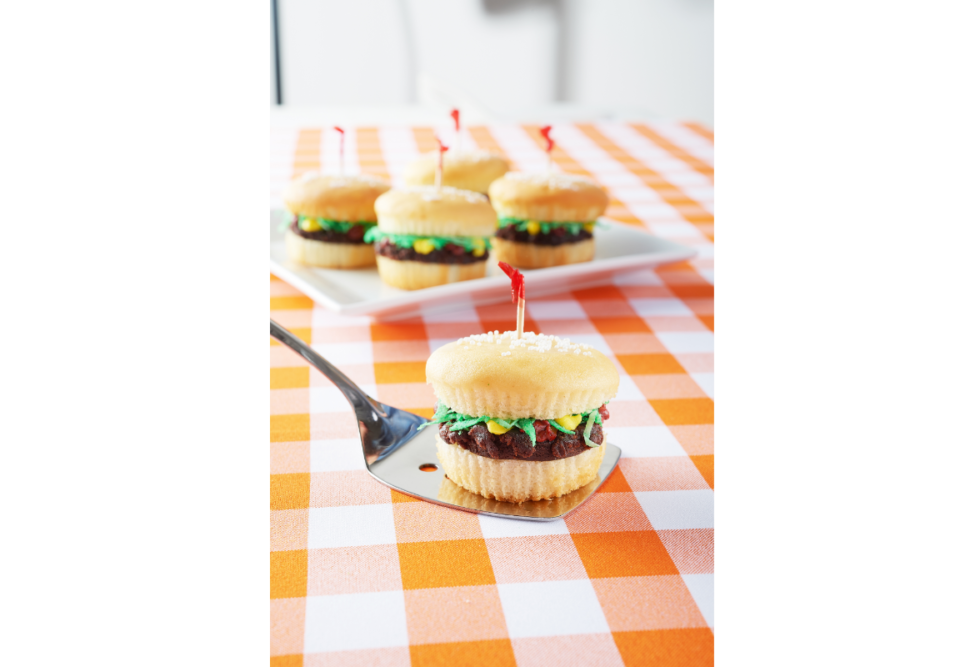While many hyper-realistic cakes need a full-time cake artist on hand to complete, executive chef Melissa Trimmer of Dawn Foods shares her take on hyper-realistic cakes that are approachable for any baker and still just as unique and fun.
Using a simple ingredient can double as hyper-realistic objects, like the classic “dirt” with chocolate cookie crumbles and gummy worms.
A unique twist on “spaghetti and meatballs” features butter creme, truffles, strawberry filling, and a classic grass tip.
With the popular Netflix show “Is it Cake?” taking the foodie world by storm with mind-bending cakes made to look like everyday objects, bakeries have an opportunity to leverage this hot trend and showcase their creative talents.
“Everyday bakers can do clever things like spaghetti and meatballs or hamburger cakes,” she said. “There are definitely ways to get on board this trend. A lot are using purchased cake rounds, so it will hold up for sculpted cakes. Cream cakes can be used for Bundt, muffins and round cakes. We also keep seeing cakes infused with flavors – a nostalgic cake design with a nontraditional flavor.
“Maybe now people are willing to try hot honey cookies – a throwback dessert with a twist.”
Trimmer identifies several key trends emerging in the cake sector. One is the evolution of floral cakes.
Say a wedding couple is planning a popular “barn” wedding, and they need the right look. Start by pressing edible flowers (you can put them in books or flatten them carefully on your workbench) and position them as eye-catching décor on the top of the wedding cake. This is called “bringing the outside in.”
“They are really beautiful,” Trimmer said. “I would use a full sheet tray with liner on the bottom and the top, and then place the flowers on very gingerly.”
Another option is individual cakes for wedding tables. Trimmer points out “what’s old is new again.”
“Sugar flowers are back. I remember 20 years ago when gumpaste flowers emerged, and there was the emergence of really beautiful intricate designs. It is really a great way to showcase talents of your cake decorators, and it’s very Instagrammable.”
Cake hoops are an emerging trend on the cake design front, as decorators are integrating plastic or metal hoops (about the size of a hula hoop) into the cake design and putting edible flowers or greens on them.
25 years of innovation
During an online panel discussion with Crystal Mier and Paul Edward, the founders/owners of Chef Rubber, based in Las Vegas, the company owners reflected on Chef Rubber’s 25 years in business and how to leverage current trends in the cake decorating segment. The discussion was part of the FIT Symposium 2022 organized by Johnson & Wales University’s College of Food Innovation Technology.
Not only does Chef Rubber offer additives, colorants, ingredients, flavorings, literature, tools, and supplies, the company recognizes the importance of dependability, accuracy, and timeliness that world-class chefs and artists require from their vendors.
“Our story begins with silicone, cocoa butter, and two chefs wanting to change the meaning of artisan chocolates and pastry. Eight colors of cocoa butter and food grade silicone changed the world of confections and pastry. Twenty-five years later we’re still here, pushing the boundaries of color and inspiration,” Chef Rubber’s owners said. “It’s a lot of hours, and there are no days off, especially in the beginning.”
“From the beginning, we really tried to see what the market needed,” Edward added. “Our business continues to evolve as the market changes. Today, we have over 7,000 products.”
Supply constraints have emerged as a No. 1 challenge in the age of COVID, he explained, and Chef Rubber wisely had planned ahead for certain environmental concerns like shipping with cornstarch packing peanuts and using recycled materials.
“We just acquired a large solar panel system, and we are generating a lot of our own electricity,” Edward said. “We decided to be more self-sufficient. We have a facility in Las Vegas with super-efficient air conditioning and now a new Park City (Utah) distribution center.”
Staying ahead of marketplace trends remains a key focus of their operations. Plant-based options, for instance are a growing trend.
Chef Rubber food colors are available in multiple forms – from powder, to liquid, gel, and paste. Which to choose will depend on the dessert, confection or beverage that is being created. The two main categories in colors for the food industry are water soluble and fat dispersible (lakes and dyes). A water-soluble colorant works best when the water content in the recipe is higher than the fat content. The best example would be when making macaron batter – the most common selection is a gel or water-based powder color that is easily mixed with the water content in the egg whites. Similarly, a fat dispersible color added to a fat-bases product like chocolate will work significantly better than adding a water-soluble colorant.
The creative mind and pastry knowledge of the Chef Rubber founders have developed and launched a full line of natural colorants. These products are derived from vegetables, fruits, herbs, and spices. Chef Rubber has natural options in both water-based and fat-based colorants.
“Plant-based products are here to stay,” Edward said, “but I think you have to look at where you are located and who is your mix of clients. You need to respond to what your customers want.”

